Did you know that less than 1% of public EV charging ports in the United States were Level 1 as of 2022? Most, about 80%, were Level 2. The fast growth of electric vehicles (EVs) depends on having enough and easy-to-use charging spots. As cars move from using gasoline to electric, we need a strong network of EV charging stations. This helps people trust in electric cars and helps cut down on global CO₂ emissions.
This article will look into the newest in charging tech and planning for charging spots. It shows how key public charging networks are for the future of driving. With more public charging spots expected to pop up, knowing about this change is important for anyone looking into the future of getting around12.
As we move forward, think about the good things and new ideas coming up. Going electric is not just possible but also a green choice.
Key Takeaways
- Charging infrastructure is key to getting more people to use EVs and feel confident about it.
- Most public charging spots in the U.S. are Level 2.
- We expect to see a big jump in public charging spots by 2035.
- We need different charging options for all kinds of EVs.
- Knowing about costs and incentives helps with planning.
The Importance of EV Charging Infrastructure
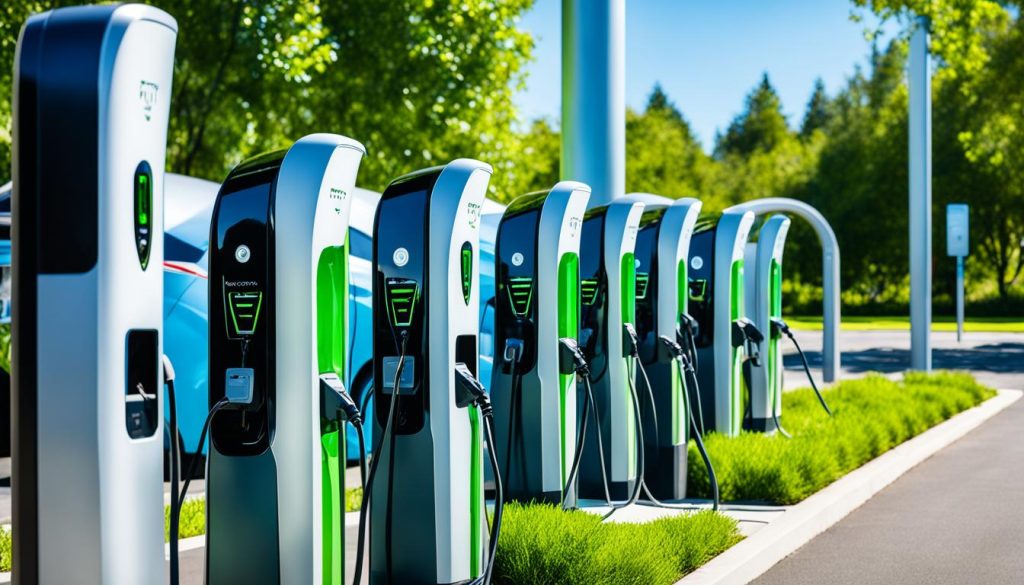
Understanding EV charging infrastructure is key to more people using electric vehicles. Without enough charging spots, people worry about running out of power. A recent survey found 61% of people said charging was a big factor in not buying an EV3.
As more electric cars hit the roads, we need easy-to-use charging spots. A 2023 survey showed 39% were worried about the car’s range and 33% about finding charging spots. Only 42% were concerned about the cost3. This shows how crucial charging stations are for people to trust and use EVs.
The EV market is expected to grow a lot, making a strong charging network even more important. The Edison Electric Institute predicts EVs will jump from 2.4 million in 2021 to 26.4 million by 2030, making up over 10% of all cars3. We’ll need about 12.9 million charging ports and 140,000 fast charging spots by then3. Right now, there are about 161,562 charging ports, but only 6,409 are fast charging, showing we need more.
How charging stations are set up affects how people use them and the costs. Level 1 charging takes 40-50 hours, but Level 2 cuts it down to 4-10 hours3. Having different types of charging spots, especially fast ones, makes using EVs better and less stressful.
In short, building a good EV charging network is crucial. It helps make switching to electric cars easier and supports environmental goals.
Understanding Electric Vehicles (EVs)
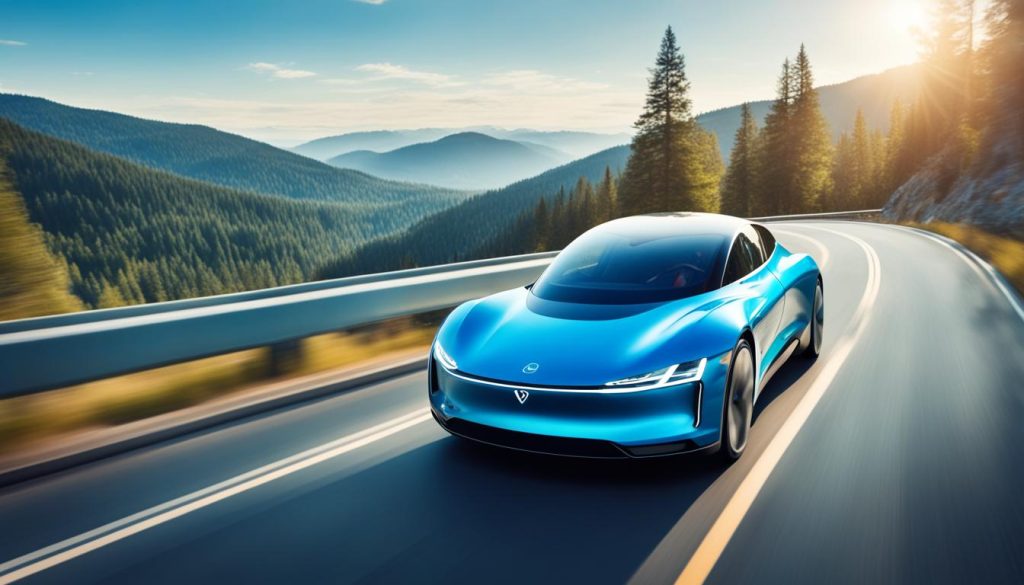
Electric vehicles (EVs) run on EV technology, which is quite impressive. They use batteries, electric motors, and regenerative braking for better efficiency. By 2022, over 3 million EVs were registered in the U.S., making up about 1.2% of all cars. EVs also made up 7% of all new car sales that year4.
There are different kinds of electric vehicles, like all-electric, plug-in hybrids, and fuel-cell electric vehicles. All-electric vehicles have become the top choice since 2016. Today, they can go over 130 miles on a single charge, using less than 40 kWh5.
The benefits of EVs are clear. They don’t emit pollutants, which helps reduce greenhouse gases. Plus, making lithium-ion batteries has gotten much cheaper, making EVs a better deal4. As people care more about the planet, learning about EVs and their perks is key to getting more people to use them.
Looking into electric vehicles, remember that cars and trucks use about 30% of the U.S. energy and 70% of the oil. Switching to EVs could help reduce this. We need more charging stations, with over 53,000 public ones and more than 137,000 charging ports in the U.S. already5.
| Vehicle Type | Example | Fuel Economy |
|---|---|---|
| All-Electric Vehicle (BEV) | 2023 Tesla Model 3 | Over 130 MPGe |
| Plug-In Hybrid Electric Vehicle (PHEV) | 2023 Toyota Corolla Hybrid | 50 MPG |
| Fuel Cell Electric Vehicle | 2023 Hyundai NEXO | Up to 61 MPGe |
Technological Advances in Charging Solutions
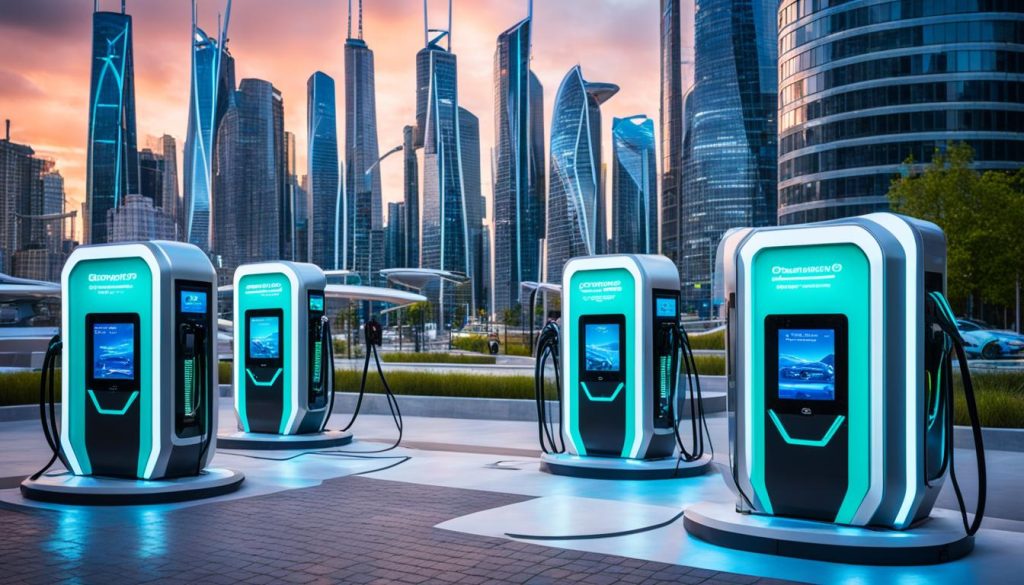
The world of electric vehicle (EV) charging is changing fast thanks to new tech. These changes make charging your EV easier and more efficient. They’re driven by the need to protect the environment, government support, and better batteries6.
Power management systems and V2G technology are big wins. They help use energy wisely and keep the grid stable. Big car companies are now focusing on smart charging solutions. These let you monitor your charging in real-time and adjust prices7.
Having lots of charging spots is key for EVs to fit into our daily lives. New battery types, like Lithium Iron Phosphate (LFP), charge faster and cost less. California is even planning to make all new EVs V2G-ready by 2027, which will help the grid7.
Wireless charging is still new but could change everything. It lets you charge your car while driving. Ultra-fast chargers can give you hundreds of miles of range in just a few minutes. This tech makes electric cars more practical and supports a greener future8.
| Technology | Description | Benefits |
|---|---|---|
| Smart Charging Solutions | Real-time monitoring and dynamic pricing | Cost savings and optimal charging times |
| V2G Technology | Allows EVs to feed energy back to the grid | Grid support and potential revenue for users |
| Wireless Charging | Charging without physical connections | Convenience and reduced wear on connectors |
| Ultra-Fast Charging | Charging stations delivering 350 kW of power | Rapid replenishment of EV batteries |
Charging Infrastructure for Electric Vehicles

The growth of charging stations is key to more people using electric vehicles (EVs). In the U.S., over 61,000 EV charging stations are open to the public as of early 2024. Almost all Americans live in a county with at least one EV charging spot9. This shows how crucial it is to improve and add more EV chargers.
Current State of Charging Infrastructure
Charging stations are not the same everywhere. In cities, 60% of people live close to a public EV charger. But in rural areas, only 17% have easy access9. California has a lot of these stations, but it’s still not enough for the number of EVs it has9.
Comparing Level 1, Level 2, and DC Fast Charging
It’s important to know about the different EV chargers. Let’s look at the main types:
| Type of Charger | Charging Speed | Best Use Case |
|---|---|---|
| Level 1 | 2-5 miles of range per hour | Home charging, slow overnight charging |
| Level 2 | 10-60 miles of range per hour | Residential and commercial use, public areas |
| DC Fast Charging | 3-20 miles of range per minute | Public charging networks, fast recharge for long trips |
New York State is investing $175 million to improve fast chargers10. This will help more people switch to electric vehicles, aiming for three million EVs by 203010.
Public Charging Networks: Bridging the Gap
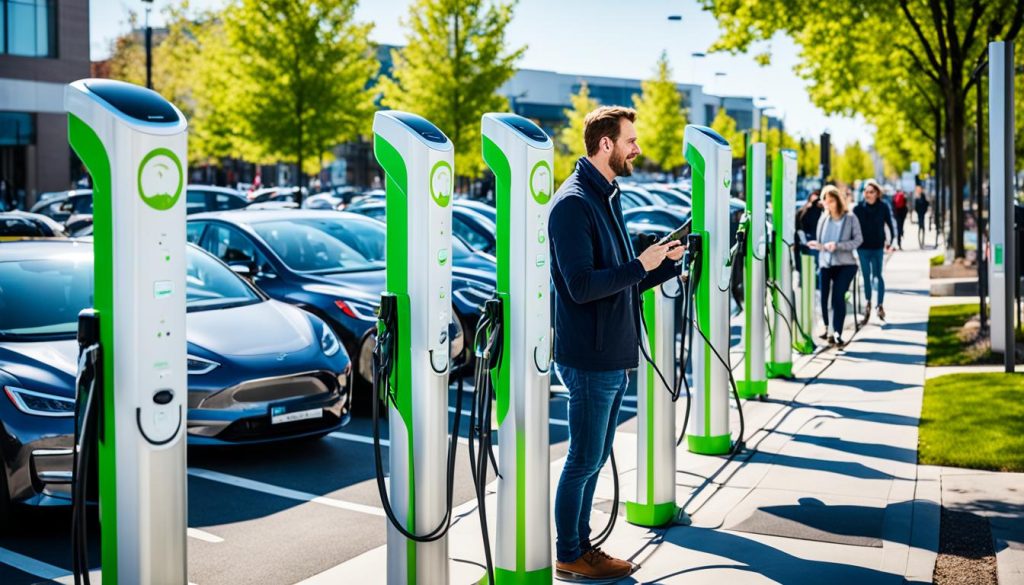
Public charging networks are key to making EV charging easy for electric vehicle owners. As more people buy EVs, the need for reliable charging spots grows. Companies like EVgo and ChargePoint are adding more stations in busy places to help drivers.
The Biden Administration wants to set up at least 500,000 public chargers by 203011. This plan includes placing chargers where they’re most useful for EV users. Over 80% of EV owners say they’d buy another EV if charging at home is easy and the car is reliable12.
Now, there are over 165,000 public charging ports, and fast charging spots have jumped by 70% since Biden became President1213. This growth is vital because many people are hesitant to buy EVs due to limited charging options12. To fix this, there’s a big push, with about $623 million in grants to improve the EV charging network, focusing on areas that need it most11.
As more people buy EVs, having lots of public charging spots is key. Making EV charging easy will help current owners and draw in new ones. This will help create a greener future for how we travel.
| Year | Public Charging Ports | EV Sales as % of Light-Duty Vehicles |
|---|---|---|
| 2020 | ~100,000 | 2% |
| 2021 | ~1.8 million | 6% |
| 2023 | ~165,000 | 18% |
Residential EV Chargers: Convenience at Home
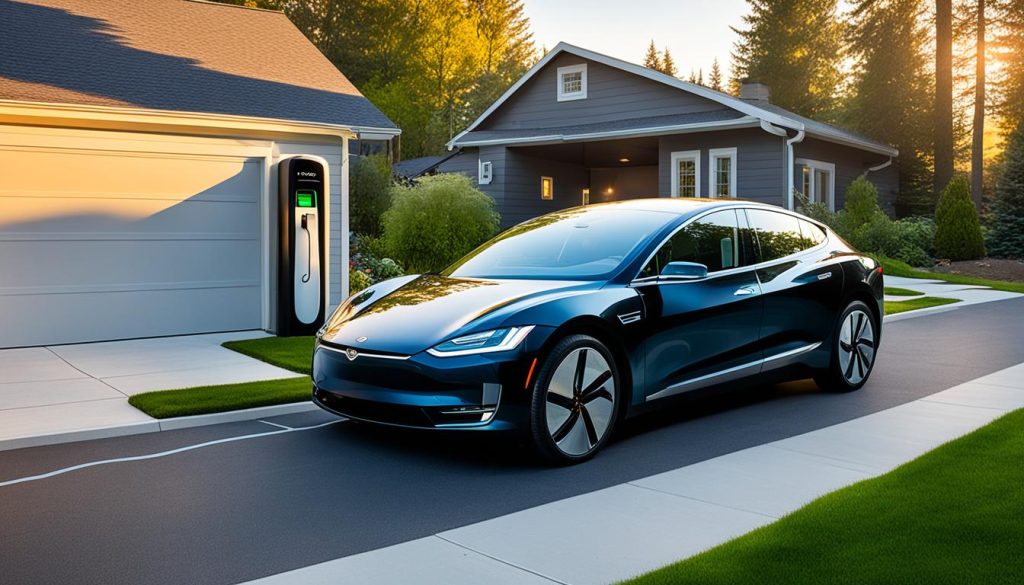
Having a residential EV charger makes life easier for EV owners. You can pick from many chargers that meet your needs. This ensures a smooth and quick charging experience at home. Knowing about the charger types and their costs helps you choose wisely.
Types of Residential Chargers
There are mainly two kinds of residential EV chargers:
- Level 1 Chargers: These chargers use a standard 120-volt outlet and can take up to 20 hours to fully charge an EV. They don’t need much setup.
- Level 2 Chargers: These chargers use a 240-volt outlet and cut down charging time. You can fully charge your car in about 4 hours. Installing a Level 2 charger might also increase your home’s value as more people switch to electric cars.
Installation Considerations and Costs
Think about your home’s electrical setup, how close to the electrical panel the charger will be, and any permits needed for installation. The cost to install residential EV chargers varies a lot, from $300 to $1,500. This depends on the charger type and how complex the installation is. Dominion Energy has a program to install and maintain a charger for about $40 a month, which could help lower your costs14
If you drive less than 40 miles a day, charging your EV at home might cost about $1 a day14. This is usually cheaper than using public charging stations, especially during off-peak hours when electricity is cheaper15. Also, joining programs like Dominion Energy’s EV Charger Rewards lets you get rebates and help the grid during peak times16.
Having a residential EV charger makes charging easier and gives you peace of mind. It also supports a greener future.
Fast Charging Solutions: Speeding Up the Charging Process
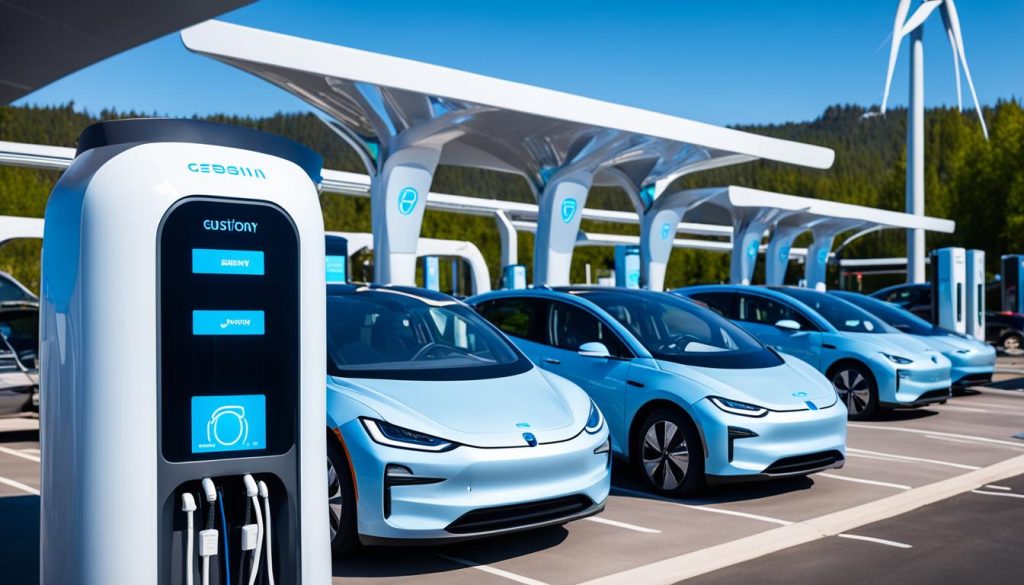
Fast charging solutions are changing how electric vehicles (EVs) get power. DC fast chargers can fill a battery to 80% in 20 minutes to 1 hour. This is key for people who are always moving1718. It cuts down the time you wait and gets your car ready for the next trip.
These quick EV charging options ease worries about running out of power. A survey found over 50% of EV owners often worry about running out of charge17. Fast charging stations are crucial, especially on highways where quick stops are needed.
The future looks bright with renewable energy and fast charging together. The Biden administration aims to install 500,000 EV chargers by the end of the decade17. This will make fast charging more accessible. Soon, super-fast chargers will be for on-the-go needs, while slower ones will be for daily use at home or work.
Charging Station Availability and Accessibility
Having enough charging stations is key to making electric vehicles (EVs) more popular. Cities like New York are picking spots for Level 2 chargers carefully. They look at demand, location, and what locals think. This makes sure everyone in the city can easily find a charging spot.
The Role of Urban Planning in Charging Infrastructure
Good city planning is vital for placing charging stations well. New York City has three DC fast charging hubs and plans for 13 more19. It’s important to have different types of chargers like Level 1, Level 2, and DC Fast Charging. This meets the needs of all users.
Addressing Charging Equity Issues in Communities
It’s important to make sure low-income areas have easy access to charging stations. The ADA and ABA Standards make sure charging stations are for everyone, including people with disabilities20. The $50 million Climate Equity Fund helps by putting charging stations in areas that need them most19. This helps make electric cars more accessible to everyone.
Power Management Technologies
Power management technologies are key to making EV charging stations work better. With more electric vehicles on the road, these systems can increase a charging site’s energy use by up to 4 times. This leads to big savings on upgrades, often in the tens of thousands of dollars21. They make sure energy is shared well among charging stations, which is crucial when many people need to charge at once21.
Smart Energy Management technology is crucial for sharing power efficiently among EVs, chargers, operators, and power providers. It helps everyone involved22. For example, it can spread power across several charging stations to prevent overloading. This lets all customers charge without overloading the system21. It also starts local batteries or generators during power cuts, ensuring charging continues21.
Power management systems shine with real-time monitoring. They give insights on how well the system is working and where it can get better. This info helps move power between vehicles based on their charge status21. Since electric vehicles sit parked most of the day, there’s a big chance to use this idle capacity well22.
As more electric vehicles hit the roads, smart power management will be more crucial. It lets us use renewable energy better, save on energy, and avoid big upgrade costs. Investing in strong power management technologies boosts charging network reliability and supports sustainable energy use22.
| Feature | Description |
|---|---|
| Energy Capacity Expansion | Can expand a site’s energy capacity by up to 4X, saving on infrastructure costs. |
| Efficient Load Balancing | Avoids over-subscription by distributing available power among stations. |
| Continuous Service | Automatically activates local energy sources during outages, ensuring uptime. |
| Smart Monitoring | Provides real-time insights to improve performance and allocation. |
| Integration of Renewables | Facilitates the use of wind and solar energy to optimize power distribution. |
Smart Charging Technology: Efficiency and Sustainability
Smart charging technology brings new ways to charge electric vehicles (EVs) efficiently. It uses real-time data and connectivity to adjust charging times with the grid and energy prices. This is key as more people use EVs, which could lead to a big increase in charging needs23.
Smart charging systems can also use V2G technology. This lets your EV send energy back to the grid during high demand times. This helps keep energy use stable and supports a greener planet. EVs are better for the environment and use less energy than traditional cars, cutting down on greenhouse gases24.
The EVI-PRO tool is crucial for figuring out how much energy you’ll need for different charging situations. It looks at how long you’ll be stopping and where you’re going. This ensures charging fits your needs and keeps the grid stable23. With more EVs on the road, having enough charging spots is more important than ever. By 2022, there were about 2.7 million public charging points, up 50% from 202025.
As more EVs hit the roads, we’re building up our charging networks. This move to electric cars is changing how cities work for the better. By 2030, we’ll have millions of charging spots, making it easy for everyone to charge their cars25.
Using smart charging tech with our current setup helps with today’s energy needs and sets us up for a sustainable future. Moving to this new charging system is key for less environmental harm and a stronger energy system.
EV Charging Incentives: Policies Encouraging Adoption
The U.S. government is playing a big role in making EV charging stations better. With federal incentives and state policies, more people and businesses are buying into electric vehicles. This makes it easier to set up charging stations.
Federal and State Incentives for EV Charging Stations
In 2020, there were ten million electric cars worldwide, making up 4.6% of all cars sold26. The International Energy Agency (IEA) says we need 230 million electric vehicles by 2030 to meet goals26. The U.S. has a $1 billion program to help grow EV charging stations, thanks to the California Public Utilities Commission (CPUC)27.
The CPUC puts 70% of its funds towards charging for medium and heavy-duty vehicles. The other 30% goes to light-duty charging, especially for homes and apartments27. The government also offers rebates for setting up EV charging in low-income areas27.
These efforts are pushing for more private investment in EV charging. With over 20 countries planning to stop selling gas cars, the U.S. is key in making electric vehicles a reality26.
| Type of Incentive | Description | Allocation Percentage |
|---|---|---|
| Federal Incentives | Rebates for EV charging infrastructure investments | N/A |
| State Policies | $1 billion transportation electrification program | 70% for medium/heavy-duty vehicles, 30% for light-duty vehicles |
| Community Support | Incentives for projects in underserved areas | N/A |
Charging Infrastructure Costs: Analyzing the Financial Implications
Understanding charging infrastructure costs is key to knowing the costs of setting up and keeping EV charging stations. These costs include yearly upkeep that can hit $400 per charger28 and extended warranties for DC fast chargers, costing over $800 per charger yearly28. The way charging stations are priced varies; while over 20% of public charging is free28, many charge users through different payment methods.
Looking into EV charging stations’ finances means checking all the costs. The EV Charging Financial Analysis Tool by Electrification Coalition helps users look into different business setups, like partnerships29. It also shows that how charging works affects the costs at these stations29.
Thinking about investments is crucial because returns change with location and how much they’re used. For instance, certain daily charging events make DC fast charging stations break even on costs28. Also, the costs and benefits of charging stations depend on things like local utility rates and car registration trends30. Investors should plan carefully, using financial analysis, to make money.
| Cost Element | Estimated Cost |
|---|---|
| Annual maintenance costs | $400 per charger |
| Extended warranty for DC fast chargers | $800 per charger per year |
| Percentage of free public charging | Over 20% |
In summary, the costs of charging infrastructure, financial analysis, and investment choices affect EV charging networks’ success. Making smart choices with detailed data analysis can improve economic results, helping the electric vehicle market grow.
Future Trends in EV Charging Infrastructure
The EV charging world is changing fast, with big changes coming. Automated and combined charging solutions will become more common. This change is key to meet the growing need as more people switch to electric cars.
A recent report shows a big jump in EV charging spots in the U.S. In the Fourth Quarter of 2023, there was a 5.0% increase in EV charging spots. Public spots went up by 5.2% and private ones by 3.5%31. DC fast charging spots saw the biggest jump, up 9.2%31.
Worldwide, there’s a push for standardizing charging. In 2023, the European Union and the U.S. both backed a megawatt charging system (MCS). This system supports charging up to 3.75 MW32. Companies like Kempower are planning to bring out chargers that can handle up to 1.2 MW by 2024. This marks the start of a new era in charging innovation32.
The Southeast U.S. led with a 7.8% increase in public charging spots in Q4 2023. This shows the focus on building strong charging networks in certain areas31. Working together between public and private groups is key to these advances.
Looking forward, focusing on what users want will be vital. As EV charging changes, we’ll see more wireless charging options. These changes will make charging EVs even easier.
By 2026, many car makers will move to third-generation platforms. This will shape future trends in charging infrastructure33. This shift will lead to a better and easier charging network. It’s crucial for making electric cars more popular and sustainable.
Global Perspectives on EV Infrastructure Development
Looking at the global EV infrastructure, we see different speeds of growth in each region. This depends on local policies and what the market needs. Countries like China, the European Union, and Norway are ahead in using electric vehicles. They’ve put a lot into international charging networks.
The global electric vehicle charging infrastructure market was worth USD 25.83 billion in 2023. It’s expected to grow by 25.4% each year from 2024 to 203034.
China has installed over 7 million EV chargers by 2022. This has greatly influenced global trends in EV infrastructure34. Fast chargers made up 72.4% of the global revenue in 202334. Level 2 charging is also getting popular, adding 12 to 80 miles of range per hour34.
In the United States, there are efforts to improve EV infrastructure with federal funding. The Joint Office of Energy and Transportation helps cities and rural areas plan and fund charging stations. This ensures everyone works together on this project35.
As more people use EVs, it’s crucial for areas to share their best practices. Working together to create strong charging networks is key. Getting communities involved is also vital. There are many resources available to help spread the word about electric vehicles35.
Conclusion
Building EV charging stations is key for electric cars and green transport. Road transport is a big source of CO2 emissions, making electric cars a vital solution36. We need a plan that includes everyone and new tech for charging.
Range anxiety is a big issue for EVs, showing we need a strong charging network36. Having easy-to-use charging spots, like at home or public stations, helps more people use electric cars36. We should make plans that fit local needs and offer different charging ways.
Looking forward, we must use smart charging and fast chargers to solve charging problems37. With everyone working together, we can make charging easy and efficient. This will help create a better transport system and a green future for our kids.
FAQ
What is EV charging infrastructure?
Why are charging stations important for EV adoption?
What types of EV chargers are available?
How does public charging impact accessibility?
What are the installation costs for residential EV chargers?
FAQ
What is EV charging infrastructure?
EV charging infrastructure is a network of stations for electric vehicles. It includes public charging spots, home chargers, and fast charging options. These are key for more people to use electric cars.
Why are charging stations important for EV adoption?
Charging stations ease worries about running out of power for drivers. This makes them more likely to switch from gas cars to electric ones. A strong charging network also makes driving electric better and helps the environment by cutting down on emissions.
What types of EV chargers are available?
EV chargers come in different types. Level 1 chargers are the slowest, using regular home outlets. Level 2 chargers charge faster and are good for homes and businesses. DC fast chargers are the quickest, perfect for public use.
How does public charging impact accessibility?
Public charging networks are crucial for filling charging gaps. Companies like EVgo and ChargePoint add more stations, especially in busy places. This makes it easier for EV drivers to find places to charge.
What are the installation costs for residential EV chargers?
Installing EV chargers at home can cost between 0 to
FAQ
What is EV charging infrastructure?
EV charging infrastructure is a network of stations for electric vehicles. It includes public charging spots, home chargers, and fast charging options. These are key for more people to use electric cars.
Why are charging stations important for EV adoption?
What types of EV chargers are available?
EV chargers come in different types. Level 1 chargers are the slowest, using regular home outlets. Level 2 chargers charge faster and are good for homes and businesses. DC fast chargers are the quickest, perfect for public use.
How does public charging impact accessibility?
Public charging networks are crucial for filling charging gaps. Companies like EVgo and ChargePoint add more stations, especially in busy places. This makes it easier for EV drivers to find places to charge.
What are the installation costs for residential EV chargers?
Installing EV chargers at home can cost between $300 to $1,500. The price depends on the charger type and how complex the setup is. It’s affected by the charger’s power and where it goes in the house.
What role does smart charging technology play?
Smart charging tech makes charging better by timing it with the grid and energy prices. It also supports vehicle-to-grid (V2G) tech, letting EVs send power back to the grid when it’s needed most.
Are there any government incentives for EV charging?
Yes, there are incentives from the federal and state governments for EV charging stations. The Inflation Reduction Act offers a lot of funding. States also give grants and tax credits to help with charging station projects.
What are the future trends in EV charging infrastructure?
The future of EV charging looks bright with automated solutions, more fast charging, and wireless tech. Working together, everyone can meet the growing need for charging spots.
How do charging infrastructure costs affect the deployment of charging stations?
Costs for charging infrastructure include buying and running stations, and the cost of electricity. Looking at these costs helps figure out if investing in charging spots is worth it. This depends on the location and how much it’s used.
,500. The price depends on the charger type and how complex the setup is. It’s affected by the charger’s power and where it goes in the house.
What role does smart charging technology play?
Smart charging tech makes charging better by timing it with the grid and energy prices. It also supports vehicle-to-grid (V2G) tech, letting EVs send power back to the grid when it’s needed most.
Are there any government incentives for EV charging?
What are the future trends in EV charging infrastructure?
The future of EV charging looks bright with automated solutions, more fast charging, and wireless tech. Working together, everyone can meet the growing need for charging spots.
How do charging infrastructure costs affect the deployment of charging stations?
Costs for charging infrastructure include buying and running stations, and the cost of electricity. Looking at these costs helps figure out if investing in charging spots is worth it. This depends on the location and how much it’s used.
What role does smart charging technology play?
Are there any government incentives for EV charging?
What are the future trends in EV charging infrastructure?
How do charging infrastructure costs affect the deployment of charging stations?
Source Links
- https://afdc.energy.gov/fuels/electricity-stations – Alternative Fuels Data Center: Electric Vehicle Charging Stations
- https://www.iea.org/reports/global-ev-outlook-2024/outlook-for-electric-vehicle-charging-infrastructure – Outlook for electric vehicle charging infrastructure – Global EV Outlook 2024 – Analysis – IEA
- https://sepapower.org/knowledge/ev-charging-infrastructure/ – EV Charging Infrastructure: Trends, Requirements & Costs
- https://www.eia.gov/energyexplained/use-of-energy/transportation-in-depth.php – Use of energy for transportation electric vehicles
- https://afdc.energy.gov/fuels/electricity-benefits – Electric Vehicle Benefits and Considerations
- https://hylan.com/the-electrifying-future-advancements-in-ev-charging-infrastructure/ – The Electrifying Future – Advancements in EV Charging Infrastructure
- https://driivz.com/blog/ev-charging-technology-innovations/ – 6 EV Technology Innovations in Electric Vehicle Charging
- https://witricity.com/media/blog/advances-in-ev-technology – Advances in EV technology
- https://www.pewresearch.org/data-labs/2024/05/23/electric-vehicle-charging-infrastructure-in-the-u-s/ – Electric Vehicle Charging Infrastructure in the U.S.
- https://www.nyserda.ny.gov/All-Programs/Charging-Station-Programs – Charging Station Programs – NYSERDA
- https://highways.dot.gov/newsroom/biden-harris-administration-announces-623-million-grants-continue-building-out-electric – Biden-Harris Administration Announces $623 Million in Grants to Continue Building Out Electric Vehicle Charging Network
- https://www.whitehouse.gov/briefing-room/blog/2023/12/11/full-charge-the-economics-of-building-a-national-ev-charging-network/ – Full Charge: The Economics of Building a National EV Charging Network | The White House
- https://nrsplus.com/blog/ev-charging-stations-making-electric-cars-a-reality/ – EV Charging Stations Making Electric Cars a Reality
- https://www.dominionenergy.com/virginia/save-energy/electric-vehicles – Electric Vehicles | Virginia | Dominion Energy
- https://www.precisebuildingservices.com/electric-car-charging/ – Home EV Charger Installation near Washington, DC
- https://www.dominionenergy.com/virginia/save-energy/ev-charger-rewards – EV Charger Rewards | Virginia | Dominion Energy
- https://www.smithsonianmag.com/innovation/what-will-it-take-to-charge-electric-vehicles-faster-180982221/ – What Will It Take to Charge Electric Vehicles Faster?
- https://www.transportation.gov/rural/ev/toolkit/ev-basics/charging-speeds – Charger Types and Speeds | US Department of Transportation
- https://www.nyc.gov/html/dot/html/motorist/electric-vehicles.shtml – NYC DOT – Electric Vehicles
- https://www.access-board.gov/tad/ev/ – U.S. Access Board – Design Recommendations for Accessible Electric Vehicle Charging Stations
- https://chargelab.co/blog/what-is-power-management – What is power management?
- https://driivz.com/glossary/smart-energy-management/ – What is EV Smart Energy Management System? | Driivz
- https://www.nrel.gov/transportation/managed-electric-vehicle-charging.html – Electric Vehicle Grid Impact Analysis and Smart-Charge Management
- https://www.nature.com/articles/s41598-023-50825-7 – Strategies and sustainability in fast charging station deployment for electric vehicles – Scientific Reports
- https://www.sciencedirect.com/science/article/abs/pii/S2210670724003068 – Digital twin enabled transition towards the smart electric vehicle charging infrastructure: A review
- https://www.iea.org/reports/global-ev-outlook-2021/policies-to-promote-electric-vehicle-deployment – Policies to promote electric vehicle deployment – Global EV Outlook 2021 – Analysis – IEA
- https://www.cpuc.ca.gov/news-and-updates/all-news/cpuc-adopts-transportation-electrification-program-to-help-accelerate-electric-vehicle-adoption – CPUC Adopts Transportation Electrification Program To Help Accelerate Electric Vehicle Adoption
- https://afdc.energy.gov/fuels/electricity-infrastructure-maintenance-and-operation – Operation and Maintenance for Electric Vehicle Charging Infrastructure
- https://www.transportation.gov/rural/ev/toolkit/planning-resources/cost-analysis – EV Planning Resources: Cost Analysis
- https://cupola.gettysburg.edu/cgi/viewcontent.cgi?article=1082&context=ger – Impact of Charging Infrastructure on Electric Vehicle Sales: An Analysis from Counties in 13 US States
- https://afdc.energy.gov/fuels/electricity-infrastructure-trends – Electric Vehicle Charging Infrastructure Trends
- https://www.iea.org/reports/global-ev-outlook-2024/trends-in-electric-vehicle-charging – Trends in electric vehicle charging – Global EV Outlook 2024 – Analysis – IEA
- https://www.evcandi.com/feature/three-key-trends-are-driving-ev-charging-market – Three key trends that are driving the EV charging market
- https://www.grandviewresearch.com/industry-analysis/electric-vehicle-charger-and-charging-station-market – EV Charging Infrastructure Market Size & Share Report 2030
- https://driveelectric.gov/ev-infrastructure-playbook – Public electric vehicle charging infrastructure playbook · Joint Office of Energy and Transportation
- https://www.iea.org/reports/policy-brief-on-public-charging-infrastructure/executive-summary – Executive summary – Policy Brief on Public Charging Infrastructure – Analysis – IEA
- https://projects2014-2020.interregeurope.eu/evenergy/news/news-article/3199/7-conclusions-on-how-to-boost-electric-mobility/ – 7 Conclusions on How to Boost Electric Mobility





